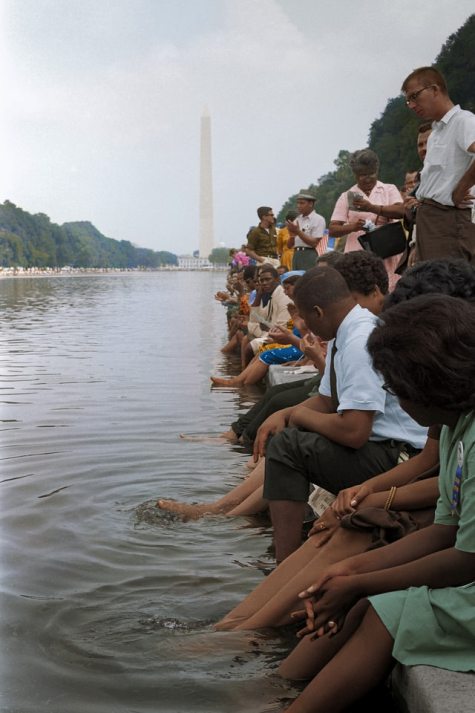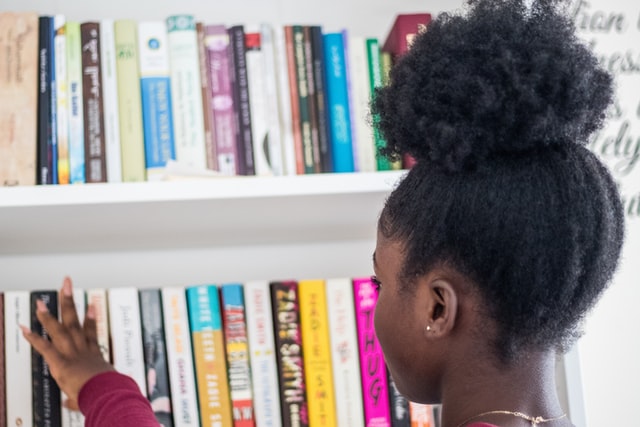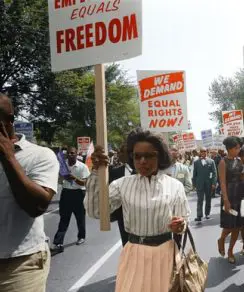During my sophomore year of high school, a classmate shot a student at another school in the cafeteria. Although the harmed student survived, school administrators felt they needed to improve school safety by bringing in metal detectors and enforcing a strict dress code—significantly and forever altering our schooling experience.
While administrators told us the implementation of these tools was needed to keep students safe, and maybe that was true from the school’s perspective, for me, it felt like a way to surveil a predominantly Black student body. Why? Because every day until graduation, we were subjected to the over-policing of our bodies and items each time we entered the building. Although they said the metal detectors were about safety, they never asked us if being searched made us feel safe.
While the metal detectors and body searches created a physically “safe” schooling environment, it was the way school administrators communicated these tools of “safety” in a way that attacked our clothes and our culture; their actions framed Blackness as unsafe. As a reminder, the fashion of the mid-2000s for masculine-presenting folks was oversized everything (e.g., tall-T-shirts, jeans, and hoodies). In many ways, such clothes embodied hip hop culture of the time—Black culture.
We were informed of these changes by administrators during a school assembly, which was not well received by some students. They told us that administrators would suspend students from school after a certain number of dress-code violations. Administrators centered these messages squarely on safety. However, when administrators told us they were changing the schools’ dress code, race was missing from the conversation. Instead, banners proclaiming “Dress for Success” started to appear on school walls. To many students, administrators’ explanations about why we could no longer wear hoodies in class and why boys had to tuck in their shirts seemed unrelated to safety. For me, it felt like an attack on our culture—on Black culture.
During an assembly, the critical nature of questions a friend and I posed about these changes landed us in the assistant principal’s office. There, he told us, “Hoodies hide students’ appearance; they make you look suspicious.” He went on to explain that our clothes “were not appropriate for school.” There we were, two Black boys with questions about a significant policy change affecting us. The person replying to us was a white man behind a computer screen, working hard to defend the school’s position. The assistant principal then played a movie file of a white male with a number of weapons hidden under his baggy clothes. This video served as the assistant principal’s rationale for the school’s change in dress code. Though my friend and I found the video hyperbolic, the assistant principal told us that the dress code was about safety—but whose safety was the school most concerned about?
The change in dress code led to random sweeps. Administrators, security guards, and paraprofessionals would enter classrooms, ask boys to stand, and inspect us. If our shirts dropped below our pockets, they would pull us from class, write us up, and after multiple infractions, suspend us. For me, these policies felt like heightened surveillance and a restriction of Black cultural expression. If the dress code was about safety, what purpose did the metal detectors serve? If the metal detectors, pat-downs, and book bag searches were for our safety, what purpose did the dress-code policy and random searches that led to suspensions serve?
Although, as a teenager, I could not articulate my issue with the dress-code policy, it was an early example of an inappropriate and misguided response that evaded race. We were Black kids being told by administrators in positions of power that the way we dressed was unprofessional, suspicious, and dangerous. Instead of critically discussing and taking a stand against gun violence, the school vilified our culture, the way we talked, walked, and dressed, suggesting that these factors rendered us the very threats to safety the school feared.
This past experience reminds me of current conversations regarding Black history and race in K-12 education. At present, teachers have access to a proliferation of materials they can use to teach about anti-Black racism in the U.S. (e.g., Nickelodeon’s Juneteenth Lesson Plan (King & Vickery, N.D.), The Crown Act, and The 1619 Project (Hannah-Jones et al., 2020 ). Unfortunately, the teaching of such materials has led some parents and politicians to erroneously blame critical race theory (CRT) as a convenient, misunderstood, and misconstrued culprit.
CRT, which began with identifying and interrogating white supremacist racism in the law (Matsuda et al., 1993) and then in education (Ladson-Billings & Tate, 1995), did not receive its namesake until it fully materialized in the 1980s with scholars working to understand how the civil rights movement had failed to eliminate racism (Matsuda et al., 1993). This theory is reserved mainly for graduate and professional education, making it widely unavailable and/or inaccessible to K-12 classroom teachers. While CRT shoulders the blame, it appears the issue is more accurately framed as teaching truthfully and critically about U.S. history.

The non-revisionist history of the U.S. is intertwined with examples of white supremacist racism. These perspectives present the “Land of the Free” as a contradiction, especially when viewed through the lenses of historically marginalized people. For some, this history is too harsh to recognize, too painfully honest for their children to learn. For example, at a recent school-board hearing in Tennessee, community members proclaimed they did not want teachers to use the book Ruby Bridges Goes to School (Bridges, 2009). Written by the trailblazer herself, the book shares her encountering anti-Black racism as the first Black child to attend an all-white elementary school in New Orleans, Louisiana. At the Tennessee school board hearing, community members argued that teachers should not use words such as "injustice, unequal, inequality, protest, marching, segregation" in the classroom (Exum, 2021). At the school-board hearing, an individual named Bridges’ description of a "large crowd of angry white people who didn't want Black children in a white school" as not fairly depicting white protesters. Similar to claims about safety that my administrators used to justify their imposition of a misinformed dress code policy, these contemporary cautions uphold white feelings of guilt and shame as paramount to the emotional abuse inflicted on Black children in conversations that circumvent honest portrayals of, for example, enslavement or de jure segregation.
As her book shows, Ruby Bridges and many other Black folks within the U.S. faced racial harm due to white supremacy. Why does this fact make white supremacy an issue to openly discuss with K-12 students? Is it because white supremacy is still an issue in education? Is it because white supremacist racial oppression is the foundation on which the U.S was constructed? Is it because parents do not want younger generations to feel the weight of their forefathers’ and foremothers’ wrongs? Why is it that some are hyper-focusing on “controversial” subject matter and not the white supremacist conditions that made race a central topic in education in the first place? These rhetorical questions illuminate a pattern: prioritizing a sanitized version of history instead of focusing on systemic white supremacy within the U.S.
To address this enduring issue, states and districts should consider endorsing an emphasis on the history of Black people and anti-Blackness in the U.S., aligning such to state standards. This focus ensures that teachers prepare students to grapple with a complete picture of Black history, within U.S American history; it also helps students connect such historical atrocities that Black people experienced in the past to current events at local, regional, and national levels. For example, Illinois once had the most sundown towns in the U.S. (Loewen, 2018). A sundown town meant danger for Black folks, who had to be out of a given town when the sun went down or risk white supremacist violence. Whether for students in Chicago or Mount Vernon, Illinois, an informed and transparent view of history is necessary and should be available for students to develop a critical view of racism’s influential role. This approach is vital for understanding how racism operates in the past and may help students understand its function in their lived realities. It may also help students learn, for instance, why their town or city is still racially segregated in 2021.
For me, as a high school student searching for more meaningful replies to my questions about the new dress-code policy, more direct and honest conversations about race and racism would have satisfied much of my curiosity and made me hold my educators in higher esteem. It’s likely that today’s students may feel something similar. Many may be yearning for transparent discussions about the role of race in their schooling and curriculum. Unfortunately, numerous states such as Texas, Florida, Iowa, Oklahoma, Arizona, New Hampshire, and Idaho are failing to meet student needs, and fifteen others are considering taking similar actions (Ray & Gibbons, 2021). Another concerning example lies in the Lone Star State, where the Texas senate recently passed a bill that no longer requires its K-12 students to learn about the Klu Klux Klan (a white supremacist terrorist group), Native American Indian history, Latinx/a/o history, the battle for women’s suffrage or the civil rights movement (Chute & Médez, 2021). In these cases, whose safety is being protected?
Despite our current polarizing and volatile political climate, it’s not too late to find ways to support educators in doing the necessary work of teaching their students to develop critical perspectives on this nation and its history. For many families of color, Black ones in particular, supplementing this history has been crucial as one of the only ways to ensure their children learn more honest depictions of their nation’s past. My parents understood that learning about race in the U.S. was a matter of safety for my brother and me. My folks encouraged us to read books about Black historical figures. They also took us to the National Civil Rights Museum at the Lorraine Hotel in Memphis, Tennessee, where Dr. Martin Luther King, Jr., was assassinated. We took multiple trips to the Charles H. Wright Museum of African American History Museum in Detroit, Michigan. These exhibits introduced me to key parts of this history that has yet to be safe for Black Americans, including:
- Reconstructed models and images of the belly of ships in which enslavers forcibly stacked Black bodies in inhumane conditions
- Written accounts of chattel slavery showing what it was like to be treated by white enslavers as less than livestock
- Horrific images of mutilated Black bodies swinging from trees after being lynched by white supremacist mobs
- Videos of white police officers utilizing batons, attack dogs, and water hoses on Black folks marching in Selma, Alabama, for civil and human rights
As a child, I struggled to process the magnitude of what enslaved Africans and their Black American descendants endured to establish the U.S. However, over time and through such experiences, I learned that each day in the lives of these Black individuals was a day without safety. Planting seeds, my parents showed me Black history and passed down stories of my family’s encounters with anti-Blackness violence because they knew their children would encounter racial oppression—because learning about race is a matter of our safety. They wanted my brother and me to know that some spaces and places in this country were unsafe for us and for us to recognize when we were being mistreated based on the color of our skin. They wanted their children to know where Black people have come from, about the humanity in our fight to survive and thrive, and that the struggle for our safety has yet to fully materialize.

My reflections here raise questions about race as an issue of safety. But whose race threatens whose safety? I’ve come to accept that I deserved to engage more deeply with this question as a K-12 student, and I believe that today’s K-12 students are worthy of the same. When thinking about the truth of the matter, this is about safety, and I think that if we were to center more on Black safety, answers to these kinds of questions might look very different than they do now.
Dr. James-Gallaway is an assistant professor in the Department of Educational Administration and Human Resource Development at Texas A&M University.
References
Bridges, R. (2009). Ruby Bridges goes to school: my true story. Scholastic Inc.
Chute, N., & Médez, M. (2021, July 20). Did Texas lawmakers remove the classroom requirement to teach KKK as 'morally wrong'? Here's what we know. Statesman.
Exum, A. (2021, July 8). Here's what to know about the debate over 'Wit & Wisdom' curriculum in Williamson schools. The Tennessean.
King, L., & Vickery, A. E. (n.d.). Black History: Juneteenth.
Hannah-Jones, N., In Elliott, M., Hughes, J., Silverstein, J., New York Times Company., & Smithsonian Institution. (2019). The 1619 project: New York Times magazine, August 18, 2019.
Ladson-Billings, G., & Tate, W. F. (1995). Toward a Critical Race Theory of education. Teachers College Record, 97(1), 47–68. https://doi.org/10.1080/10282580701850413
Loewen, J. W. (2018). Sundown Towns: a Hidden Dimension of American Racism. The New Press.
Matsuda, M. J., III, L. C. R., Delgado, R., & Crenshaw Kimberlé. (1993). Words that wound critical race theory, assaultive speech, and the First Amendment. Routledge, Taylor & Francis Group.
Ray, R., & Gibbons, A. (2021, July 14). Why are states banning critical race theory? Brookings.